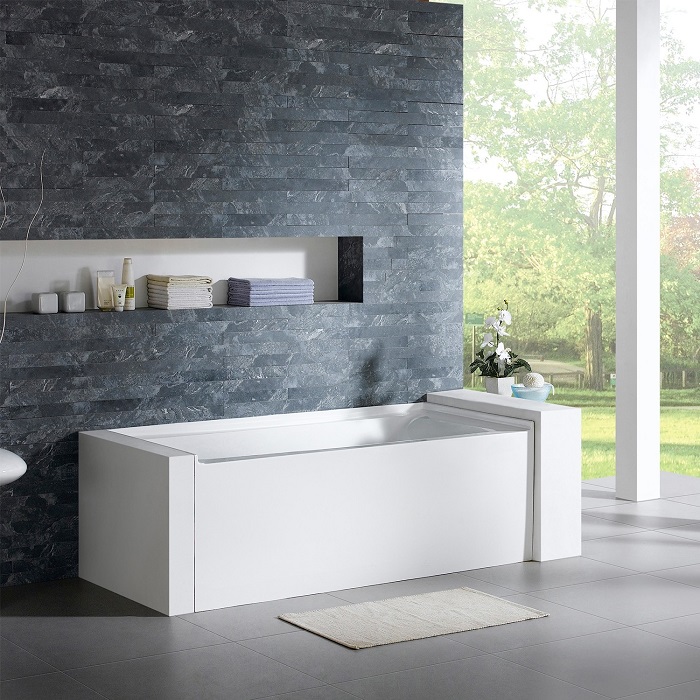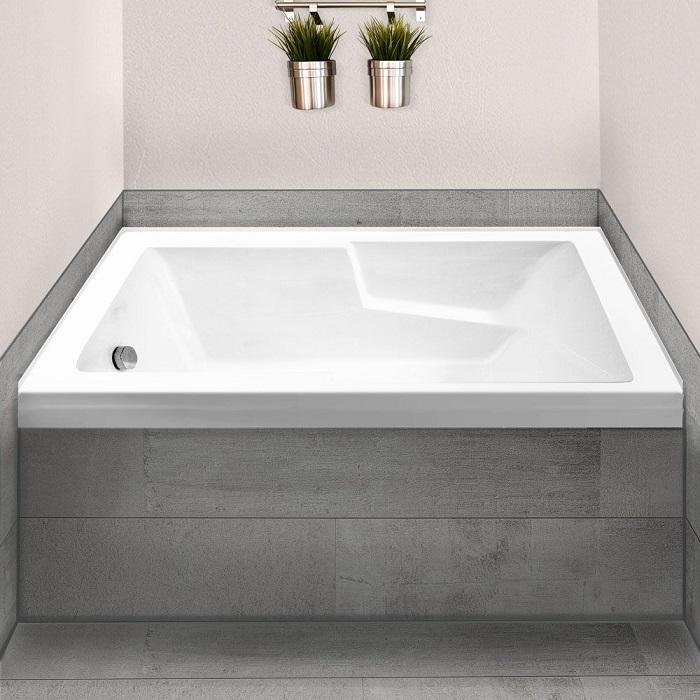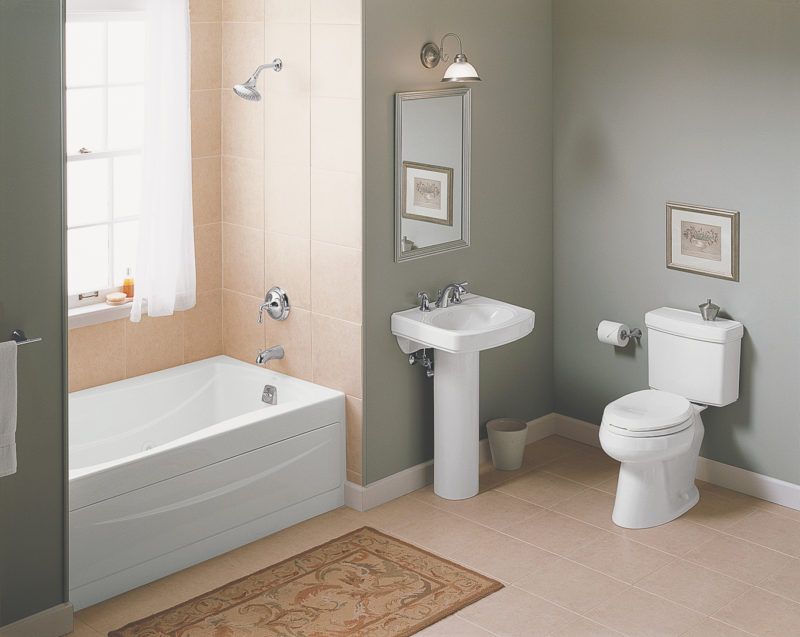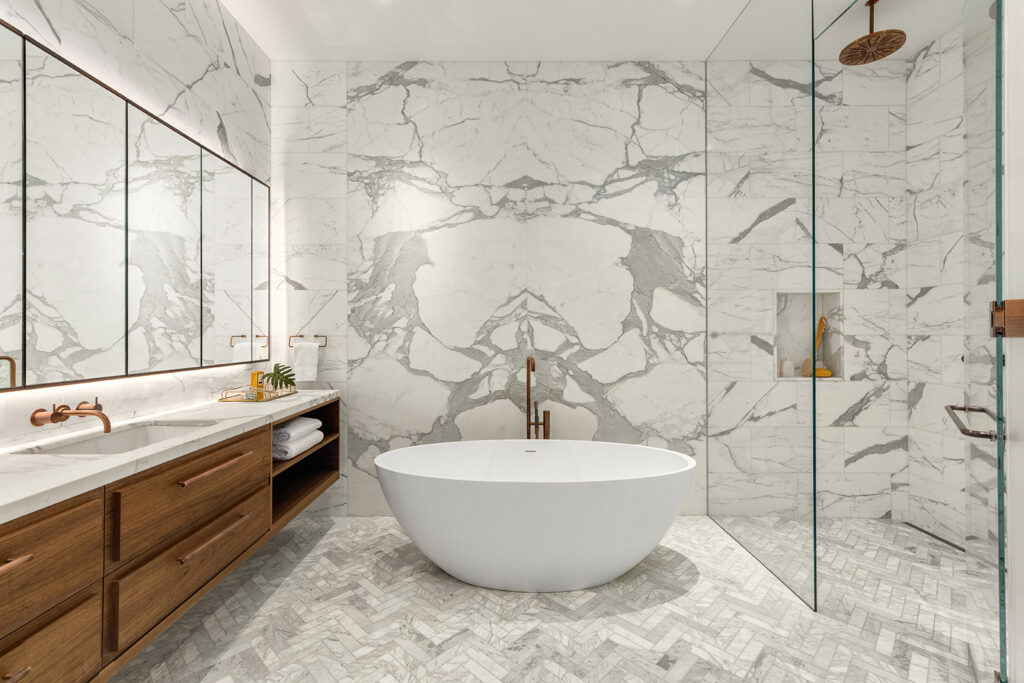
One-Piece vs Two Piece Toilet – Pros and Cons- 2025 Expert Guide
When upgrading your bathroom, one of the most important—and often overlooked—decisions is choosing between a one-piece or two-piece toilet. While
Searching for a new bathtub can be quite a daunting task with so many options for styles and customization available to you on the market. However, most of your choices will easily boil down to one question: How big is your bathroom? For those with a more space-conscience focus, an alcove bathtub is a popular choice due to its compact yet versatile design.
An alcove bathtub is not really a bathtub type but more the installation method for which it is installed. The term refers to the bathtub being installed into a recess in your bathroom, which means quite commonly they are installed with three joining walls or a pocket alcove in your bathroom, with some modern designs only having two walls or a large window to remove the confined nature of this installation method. A shower curtain or sliding door being added is quite typical as this installation method leaves an open space that doesn’t provide much privacy.

As you may know, the bathtub is quite an old invention, dating back to ancient Rome. However, the built-in tub is a modern innovation, beginning in the early 1900s with companies like Kohler integrating a bathtub design to suit people with space constraints that simply couldn’t fit a flat-footed tub into their bathroom.
While the flat-footed bathtub was comforting and elegant, it was notoriously difficult and tedious to clean due to its high verticality. This would give rise to the built-in bathtub-made with one enclosed side, this bathtub was highly efficient as it could run flush with the entire bathroom wall, saving space and allowing for better access to its surfaces for easier maintenance.
And while modern bathtubs have evolved in many forms, the alcove design is still widely prominent today, offering all the comforts of a normal bathtub in a small space. This design is particularly beneficial for urban apartments or compact homes, where bathtubs for small spaces can maximize both functionality and style without compromising on comfort.

“Before deciding if an alcove bathtub is the right choice for your bathroom, it’s important to consider both the benefits and limitations. The table below outlines the key pros and cons of alcove bathtubs, providing a clear overview to help you make an informed decision.”
| Pros of Alcove Bathtubs | Cons of Alcove Bathtubs |
|---|---|
| More Affordable Than Other Bathtubs | Limited Installation Options |
| More Practical for Everyday Use | Low Resale Value |
| Can Be Turned into a Combination Shower | Not Attractive/Mediocre Look |
| More Storage | Not Many Material Options Available |
| Easy to Install | |
| Space Efficient |
Alcove bathtubs are often more budget-friendly compared to other types of bathtubs, such as freestanding or drop-in models. This affordability is due to their simpler design and easier installation process, which typically involves fewer materials and less labor. For homeowners looking to renovate a bathroom on a tight budget, choosing an alcove bathtub can free up funds for other upgrades, such as new fixtures or tile work. Additionally, the cost-effectiveness of alcove tubs makes them a popular choice for rental properties and budget-conscious renovations.
Alcove bathtubs are designed to maximize functionality in a compact space, making them highly practical for daily use. Their standard size and shape make it easy to find compatible shower curtains and fixtures, simplifying the setup process. The three-wall enclosure of an alcove tub provides a natural barrier for water, reducing the likelihood of splashes and leaks. This practicality makes them ideal for busy households where multiple people may need to use the bathroom throughout the day.
One of the most appealing features of alcove bathtubs is their ability to be transformed into a combination shower and bath. This versatility is especially beneficial for small bathrooms where space is limited. By installing a showerhead and a suitable curtain or door, you can enjoy the convenience of a shower without sacrificing the luxury of a bathtub. This dual functionality is ideal for families, as it provides options for both quick showers and long, relaxing baths.
The alcove design often allows for additional built-in storage options, such as recessed shelving or ledges along the walls. These features can be used to store toiletries, towels, and bath products, helping to keep the bathroom organized and clutter-free. This added storage is particularly useful in smaller bathrooms where space for cabinets or shelves may be limited. By utilizing the walls around the tub, you can keep essential items within easy reach while maintaining a clean and tidy appearance.
Alcove bathtubs are generally easier to install than other bathtub types because they are designed to fit snugly into a pre-existing alcove space. This straightforward installation process often involves securing the tub between three walls, making it a relatively quick and simple project for a professional plumber. This ease of installation not only reduces labor costs but also minimizes the disruption to your home during the renovation process. For homeowners looking for a hassle-free upgrade, an alcove tub is a convenient option.
Alcove bathtubs are designed to fit into a standard-sized bathroom without taking up too much space, making them an excellent choice for smaller bathrooms or guest baths. Their compact design allows them to be installed in a corner or along a wall, freeing up floor space for other bathroom fixtures and furniture. This space efficiency makes them a practical solution for maximizing the usability of a small bathroom while still providing a comfortable bathing experience.
The design of alcove bathtubs requires them to be installed against three walls, which limits their placement options within the bathroom. Unlike freestanding tubs that can be positioned anywhere, alcove tubs must be installed in a specific location, often dictated by the bathroom’s existing layout. This restriction can be a drawback for homeowners who want more flexibility in designing their bathroom space. Additionally, it can make it difficult to incorporate an alcove tub into more unique or unconventional bathroom layouts.
While alcove bathtubs are practical and affordable, they may not add significant value to a home’s resale price. Their common and utilitarian design is less likely to appeal to potential buyers who are looking for more luxurious or visually striking bathroom features. High-end homebuyers often prefer freestanding or jetted tubs, which are seen as more desirable and can increase a home’s appeal. As a result, installing an alcove tub may not be the best choice for homeowners looking to boost their property’s market value.
Alcove bathtubs are generally considered functional rather than aesthetically pleasing. Their standard size and shape, combined with their three-wall installation, often result in a look that is more utilitarian than stylish. While they can be customized with different tiles and fixtures, their basic design limits the ability to create a truly unique or luxurious appearance. For homeowners who prioritize design and aesthetics, an alcove bathtub may not provide the visual impact they are looking for.
Alcove bathtubs are typically available in a limited range of materials, such as acrylic, fiberglass, or enameled steel. These materials are durable and easy to maintain, but they may not offer the luxurious feel or visual appeal of options like cast iron or stone. This lack of variety can be a downside for those looking to customize their bathroom with unique or high-end materials. Additionally, the limited selection may make it difficult to find an alcove tub that perfectly matches the desired look and feel of the bathroom.
Common Alcove Bathtub Sizes
| Size Category | Length | Width | Water Depth |
|---|---|---|---|
| Smallest Alcove Tub | 48 inches (4 ft) | 25 inches (2 ft) | 16 inches (1.3 ft) |
| Standard Alcove Tub | 60 inches (5 ft) | 30 inches (2.5 ft) | 18 inches (1.5 ft) |
| Largest Alcove Tub | 72 inches (6 ft) | 42 inches (3.5 ft) | 20 inches (1.6 ft) |
Size Limitations:
Alcove bathtubs are designed to fit a variety of bathroom sizes, typically ranging from 4.5 to 6 feet in length and 2.5 to 3.5 feet in width. This makes them an excellent space-saving option for smaller bathrooms but may feel undersized in more spacious settings. If your bathroom has more room, an alcove bathtub might not fully utilize the available space.
As the alcove bathtub is seen as the mainstay or standard bathtub model, many are outfitted with a shower, blending the form and functionality of a shower with the compact nature of the alcove design. Even if you have just a normal alcove tub in your home, installation of a shower is quite simple and will add increased value to your home. But beyond just saving you space in your bathroom, alcove bathtubs come in a variety of different styles for a more therapeutic role-customizable and powered jets exist on a few models, ensuring a more relaxing bathing experience. While there are a few with a deeper water height, giving you a deeper soak which is useful for bathing with oils or muscle relaxation. The great thing about all of these types is that they all fall into the size range as discussed earlier, so you can retain the added benefit of higher end bathtubs even if your bathroom is of modest size.

The primary materials for bathtubs in the alcove style are fiberglass, acrylic, cast iron, and stone resin. Each has their advantages and disadvantages but ultimately your final decision will rely largely on your budget.
Fiberglass is constructed from forming layers of fiber-reinforced plastic then layering the plastic into sheets which become a mold coated with gel-coat resin. Fiberglass is always going to be your cheapest material option, but it is porous, meaning it will warp over time and become unstable, lowering its overall lifespan. It also can’t weather heavy impacts and will chip quite easily.
A step up from fiberglass is acrylic, which is constructed similarly to fiberglass bathtubs, but it is reinforced with vacuum sheets of acrylic, making the material tougher and lowering the water absorption rate, meaning it will not absorb water, making it a stable bathtub material. However, acrylic tends to discolor over time, and still cannot weather heavy impacts.
Pros
Cons
Cast iron is considered a higher end material, at least when compared to fiberglass and acrylic, improving on much of the drawbacks from both of these materials. Made from pouring molten iron into a mold, cast iron is incredibly durable, easy to clean and retains heat very well. The only drawback is that cast iron is a great deal heavier than acrylic or fiberglass which may cause some problems if your floor is not reinforced, in addition to heavier labor being required for installation. Cast iron also happens to be a great deal more expensive than both acrylic or fiberglass bathtubs.
Pros
Cons
Lastly is stone resin or solid stone, which is constructed from taking natural stone then binding them with a special resin. Stone resin is incredibly durable, has excellent heat retention, requires very little maintenance and can weather heavy impacts without noticeable scuffs or damages. The only real drawback to stone resin is that it is also a heavy material, which will require additional considerations in floor reinforcement and increased labor on install along with a similar price tag to cast iron.
Stone Resin Pros and Cons
Pros
Cons
Typical cost of an alcove style bathtub, not including installation fees fluctuate between $250-500. For the larger sizes with more advanced features like powered jets and deeper soaking, the price jumps to around $1,000-3,000. For installation, you are looking at anywhere between $7501,000 additional if you are hiring a contractor.
If you plan on doing DIY installation, however, the price typically ranges around $150-200 depending on the existing framework in your bathroom. Factors such as your existing tile, the state of your drywall and your pre-existing flooring will contribute greatly to your cost and the amount of work you may need to apply.
A drop-in bathtub is a bathtub that can be dropped anywhere, offering you greater freedom in installation options. These bathtubs are finished all the way around, meaning that their material will not poke out and is flush with your walls and surrounds though this means they have no active edge to place or support it. They do not require walls to be installed against it, which ultimately means they can be installed similar to a freestanding bathtub so long as a pre-existing foundation or platform is constructed ahead of time.
Drop-in bathtubs also have greater flexibility in size as they aren’t limited by wall confines, which means they can be much, much bigger than alcove bathtubs meaning they have a greater water capacity which translates into greater water depth for longer soaking time. And because they do not need to be confined in size, drop-ins also have a greater variety of designs such as oval, round or rectangular, whereas alcoves are generally just rectangular. Drop-in bathtubs are much more expensive than alcove tubs.
Quite similar to alcove bathtubs, skirted bathtubs are drop-in bathtubs that have a skirt or rim that covers the entire bathtub itself. The rim is flair outwards, providing a grip or edge for it to rest on top of, allowing for easier install. This means that you simply need to drop your skirted tub over the ingress or hole you wish to install it in and seal it with caulk.
The skirt or rim will rest easily on your material while being anchored by two walls. Overall, this means that the skirted bathtub is supported by its lip and the two walls, unlike a normal drop-in which requires an empty frame first before installation.
To install an alcove bathtub, you first need to measure your surface area for where you want to install your bathtub.
As the routine standard for most homes, alcove bathtubs are relatively easy to install, requiring a few hours and roughly $70-100 of equipment. If you are unsure of any step, please consult a professional before installing.
Alcove bathtubs are a popular choice for their space-saving design and functionality, but like any bathroom fixture, they require regular maintenance to keep them looking their best. Proper care not only extends the lifespan of your tub but also ensures a clean and hygienic bathing environment. Here are five essential tips to help you care for your alcove tub and keep it in pristine condition.
To prevent soap scum and mildew buildup, clean your alcove tub regularly using a mild, non-abrasive cleaner. Avoid harsh chemicals that can damage the tub’s finish, especially if it’s made of acrylic or fiberglass. A mixture of warm water, dish soap, and a soft sponge is usually enough to keep the surface spotless. For tougher stains, use a paste of baking soda and water, then rinse thoroughly.
After every bath or shower, rinse the tub with warm water to wash away soap residue and prevent water spots. Use a squeegee or a soft cloth to wipe down the surfaces, paying special attention to corners and edges where water can accumulate. This simple habit can prevent mold and mildew growth, keeping your tub looking fresh and clean.
When scrubbing your tub, steer clear of abrasive tools like steel wool or harsh scrub brushes, as these can scratch and damage the surface. Instead, opt for a soft sponge or microfiber cloth. For stubborn grime, let your cleaning solution sit for a few minutes before gently wiping it away. This approach will help maintain the tub’s smooth finish and prevent unsightly scratches.
Regularly inspect the caulking and grout around your alcove tub for any signs of cracks or leaks. Water damage can quickly deteriorate the surrounding walls and floor, leading to costly repairs. If you notice any issues, reapply caulk or grout as needed to seal gaps and prevent water from seeping into unwanted areas.
To prevent scratches and stains from bath products, use a bath mat or liner inside the tub. This is especially important if you have children or frequently use bath oils and salts, which can damage the tub’s surface over time. A bath mat also provides additional grip, making the tub safer to use, especially for older adults.
By following these care tips, you can maintain the beauty and functionality of your alcove tub for years to come, ensuring a comfortable and relaxing bathing experience.
Selecting the right alcove bathtub for your bathroom involves more than just measuring the space. It’s essential to consider your specific needs, preferences, and the overall design of your bathroom to ensure you make a choice that’s both functional and aesthetically pleasing. Below are five steps to help you choose the perfect alcove tub for your space.
Before purchasing an alcove tub, accurately measure the available space in your bathroom. Alcove bathtubs are designed to fit snugly between three walls, so ensure you have the right dimensions for the length, width, and height of the tub. This will prevent any installation issues and ensure the tub fits perfectly in your chosen location.
Alcove tubs come in a variety of materials, each with its own benefits and drawbacks. Popular options include acrylic, fiberglass, and enameled steel. Acrylic and fiberglass are lightweight and affordable, but may not be as durable as enameled steel, which offers greater longevity but can be heavier and more expensive. Choose a material that fits your budget and maintenance preferences.
Think about how you plan to use the bathtub. If you prefer soaking, opt for a deeper tub with a comfortable backrest. Some alcove tubs offer ergonomic designs or additional features like armrests, which can enhance your bathing experience. Selecting the right depth and comfort features will ensure the tub meets your relaxation needs.
Alcove tubs often come with built-in storage options, such as recessed shelves for toiletries. Consider whether you need additional storage around the tub area and look for models that include these features. Also, think about adding accessories like a handheld showerhead or a sliding door to maximize the functionality of your alcove tub.
If you plan to use the alcove tub as a shower-bath combination, ensure it’s compatible with shower conversion. Look for tubs with flat rims to support a shower curtain or door, and make sure there’s enough wall space for a showerhead installation. This flexibility is ideal for households that need both shower and bath options in a single unit.
By following these steps, you can select an alcove bathtub that suits both your practical needs and design preferences, ensuring a seamless and enjoyable bathing experience.
There are numerous choices of bathtubs out there, making it equally important to understand your price range and the amount of space you are working with. Although it may not be as glamorous or resplendent as other bathtubs on the market, an alcove bathtub is always a safe choice due to its inexpensive price point and the small space it takes, but ultimately the decision is yours.

Eric is the founder and president of Badeloft USA. He has been the president of Badeloft’s US division for over ten years and oversees all marketing and branding aspects of Badeloftusa.com.
His expertise lies in small business development, sales, and home and bathroom industry trends and information.
Contact us with any business related inquiries.

Free material samples and tub templates

When upgrading your bathroom, one of the most important—and often overlooked—decisions is choosing between a one-piece or two-piece toilet. While

Small details, including what you place on the floor, can make a big difference when setting up or upgrading your

Plumbing traps may seem like small components, but they are critical in keeping your home safe and odor-free. Two of
When shopping for new bath linens, the difference between a bath towel and a bath sheet can feel subtle, but
Request your free material sample below. By submitting, you agree to receive occasional product updates and offers from Badeloft. Unsubscribe anytime.
"*" indicates required fields
"*" indicates required fields
"*" indicates required fields
Interesting, but not quite specific enough for the lay-person. Some side-by-side pictures of each style would have been a lot more helpful. I’m still confused about what the difference is.
Thanks for the recommendation, we’ll look to get some photos up.
Interesting, but not quite specific enough for the layperson. Some side-by-side pictures of each style would have been a lot more helpful. I’m still confused about what the difference is.